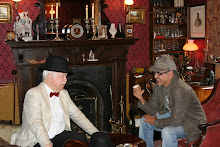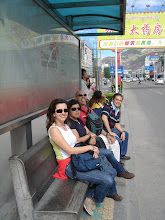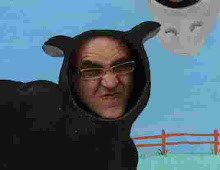I get up in the morning decided to move around the colonial área of Villa de Leyva, to take everything i tis got to offer, which in reality gives me na unsuspected richness. I grab my friends while we jump into the car rented in Bogotá, and laughing out loud the happiness we feel in our hearts we just head to Raquirá (near 30 km from Villa de Leyva), another coulored colonial city that is considered the colombian capital of pottery. In 1994 it was considered one of the most beautiful places of colonial Boyacá by the Corporacion Nacional de Turismo de Colombia. In the local indian language Raquirá means the Land of Pottery. And so we got lost in that beauty full of history that ends up in a overwhelming meal in a famous local restaurante.
And with the brain somehow dizzy by the wine that followed the meal we pu tour legs on the way towards the famous monastery that religiously rule the region. The monastery Ecce Homo that owns its title from the famous painting with the same name, that was stolen in Rome by a spanish soldier. The daughter of that soldier, Catalina Casallas, dreamt with a saint, talked to his brother and the monastery was born. In 1998 it became arquitectonic heritage of Colombia. I breath the peace that always come from thes places, but i also feel the brutality of the church on those dark times of cristianization.
From there, we just followed our path back to Villa Leyva, stopping by another local amazing place: The House of Terracotta a life project of the Colombian arquitect Octavio Mendoza, the biggest piece of pottery in the world as he like to name it. It was built exclusively by hand using only clay and baked in the sun and without any single piece of cement or steel. Inside, the rooms curve and flow into each other, as though the entire house was cast in a single mold. The dream of Mendoza gives not only the fantastic piece of work that i tis, but also points out a way to built handicraft houses making use of the most famous thing of the region (pottery). As divine as the monastery that we had visited a few hours before.
As usual, i just melt the music (Como el Humo by Mama Patxanga, Cantate Domino by Les Petites Chanteurs de Montigny, Maria Magdalene y Maria Jacobi by Tudor Consort and Be Free by Derek Clegg) that echoes in my ears, expecting to activate the travelling soul that must inhabits every soul of those that read my stories
Kisses & Hugs and… get happy.
Levanto-me pela manhã decidido a envolver a zona de Villa Leyva com aquilo que ela tem para me ofertar, o que na realidade me traz uma riqueza insuspeita. Agarro-me aos amigos enquanto saltamos para dentro do carro alugado em Bogotá e, gargalhando alto pela serenidade que aquele ambiente nos trás dirigimo-nos a Raquirá (a cerca de 30 km de distância), uma colorida cidade colonial que é considerada a capital do barro artesanal da Colombia e foi agraciada em 1994 pela Corporacion Nacional de Turismo como um dos sítios mais bonitos da provincia de Boyacá, graças à pitoresca decoração das suas casas. Na língua indígena, Raquirá significa a terra dos Potes. Manhã santa deleitando-me com essa beleza impregnada de história que acaba com uma lauta refeição bem regada num famoso restaurante local.
Bem regadinhos, apontamos baterias ao famoso convento dominicano do Século XVII que religiosamente domina a região e que deve o seu nome (Monasterio Ecce Homo) ao quadro do Santo Ecce Homo que foi saqueado em Roma e trazido para o Novo reino de Granada (Colombia) por um soldado espanhol cuja filha Catalina Casallas haveria de sonhar com esse convento e acabaria por convencer o irmão a construi-lo. Em 1998 foi declarado património arquitetónico da lista de bens culturais da Colombia. Respiro-lhe a paz que sempre ascende nesses sítios, mas também lhe sinto a opacidade feroz com que foi feita a colonização cristã, sobretudo a espanhola.
Regresso no cair da tarde a Villa Leyva, passando pela espantosa casa de Terracotta projeto de vida do arquiteto colombiano Octavio Mendoza. A casa foi toda feita em argila, a lembrar os adobes dos climas secos, completamente moldada pelo dito arquiteto, e construída à mão, sem um único pedaço de cimento ou de aço. Espantosa a modernidade, a simplicidade e o conforto dessa casa totalmente construída em argila de formas arredondadas e perfeitamente integradas no cenário montanhoso que a envolve. O sonho de Octavio Mendoza, oferece não só a originalidade que ela constitui como aponta caminhos para se construirem casas de modo económico, baseadas no trabalho artesanal que dá riqueza à região (a olaria). Tão divina como o mosteiro por onde passei umas horas antes.
Junto-lhe novamente uns pós da música (Como el Humo de Mama Patxanga, Cantate Domino de Les Petites Chanteurs de Montigny, Maria Magdalene y Maria Jacobi de Tudor Consort e Be Free de Derek Clegg) que me ecoa os ouvidos durante este pequeno périplo de maravilhas de Boyacá, com o que espero activar a alma viajante que habita em todos os que me lêem.
Beijos e abraços e…sejam felizes.
.jpg)



